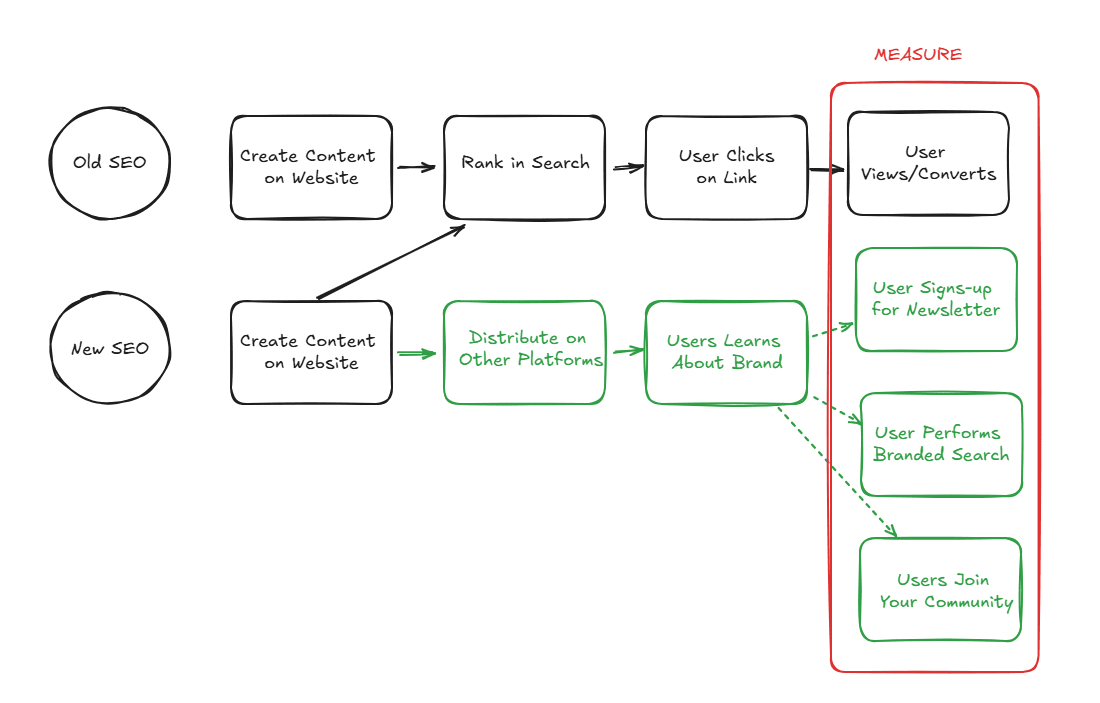Data-Driven SEO: How to Adjust Your SEO Strategy With Data
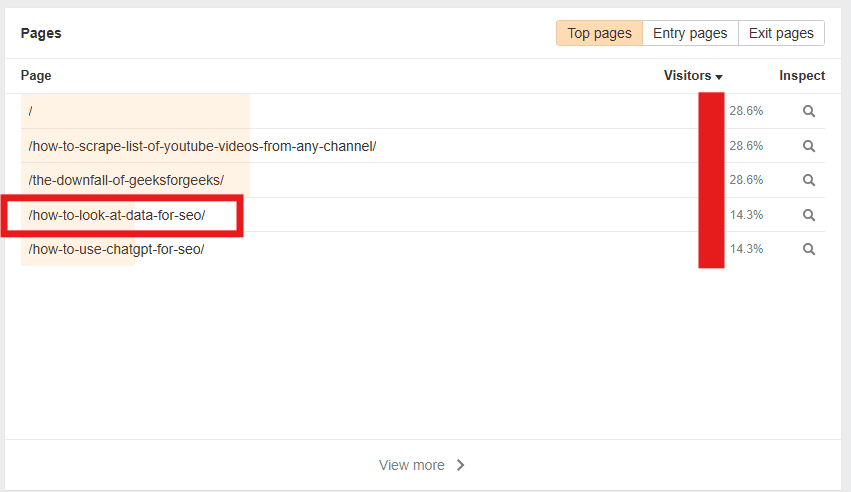
This edition of the SEO Riddler is brought to you by Ahrefs. Ahrefs is an all-in-one marketing intelligence platform. Thank you Ahrefs for sponsoring this post!

If you’re following me on LinkedIn, you’ve probably heard me say 2 things over and over:
- A strategy is not a checklist
- Strategy is about making a decision
And if you look at both those points, they are connected. If you’re not using a checklist as your SEO strategy, what are you going to do then? exactly... Which leads to the second point, a strategy is about making decisions, things around “this will work in that situation, and this won’t”.
There’s a lot of buzzwords in the industry from “ai-powered” to “GEO” and such… and “data-driven” is one of those terms that are attached to many client pitches. Which pops the question, what is data-driven and are we really driven by data?
What is data-driven SEO?
Data-driven SEO uses analytics and performance metrics to guide optimization decisions. It relies on data from tools like Google Search Console, analytics platforms (like Google Analytics or the, free Ahrefs Web Analytics), and keyword trackers to improve rankings, user experience, and content performance through measurable actions.
Got this definition from Steve Toth Snippet Brain Tool 😂 but you get the idea.
As I was looking for data around being “data-driven” in SEO. I found this interesting 2023 poll from Artios. When asked what is the process that holds the highest priority for being data-driven in SEO these were the results:
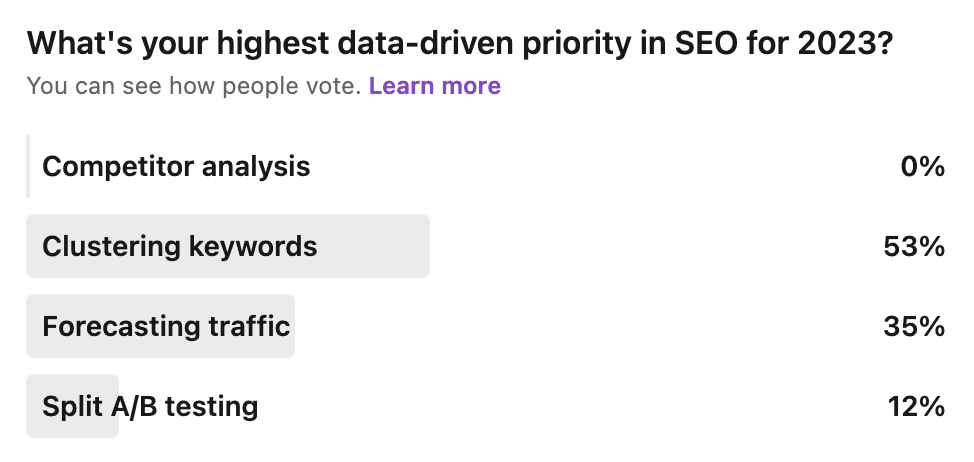
Turns out, most SEOs think that keyword clustering and forecasting are the top priority processes to be data-driven. Is this correct?
I don’t disagree, but I don’t agree either. I just think “it depends” on what you’re trying to do… right? I mean, these processes are important but they focus on one side of the story. Truly data-driven SEO requires pulling insights from a wider range of sources, looking beyond just keywords and forecasts. With them I would include a more holistic view of the data...
You’re probably now thinking “Alright Sara, enough buildup, just tell me how already”.
How to be data-driven?
To be data-driven, you need to know:
- What data to collect
- How to segment data
- How to analyze patterns
- Know how to correlate data (and differentiate between correlation and causation)
While there's no single rigid process, once you've gathered insights from various data sources (which we'll explore next), structuring your actions can be helpful. One common flow looks like this:
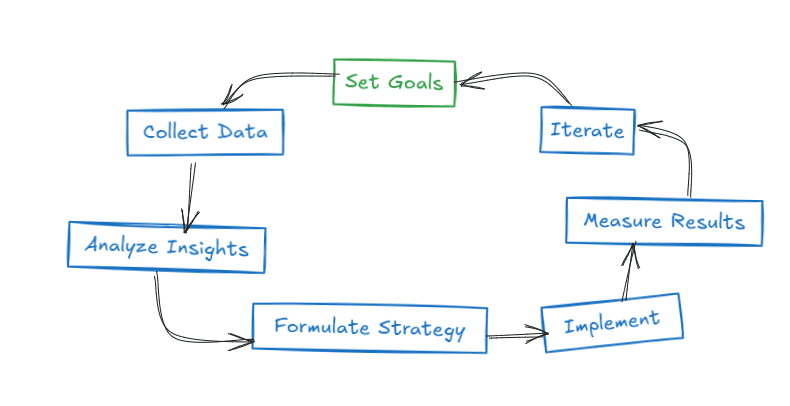
1# Decide what you want to do. Set your goals, is it an increase in traffic or conversions? Or you’re launching a new product and want to get more awareness about it? Always begin with the ideal end in mind.
2# Decide what data you need to look into. I follow an approach of less is more, you don’t have to spend hours analyzing data, but you also need to be transparent about what your data is and the assumptions you made if any.
3# Ask yourself “then what” or “why”... these 2 questions will help you pull tons of insights from your data.
4# Now decide on your actionable next steps.
5# Implement!
6# Measure your results (reporting) to understand what worked and what not.
7# Start again!
We can keep talking about theory of data and being data-driven for hours. Let's dig into an example of how data informed even the creation of this post!
Data-driven SEO decision making example
An easy example is just looking at how I decided on the topic for this blog! Here's my easy data-driven approach.
External data:
- Industry trends: one of the most trending topics in SEO right now is the “evolution of SEO” and with that comes the need for new approaches and a lot of analysis and looking at data.
- Keyword research: Played around a bit and did some keyword research and came across this keyword “data-driven seo strategy adjustments” which is right up my alley!
Internal data:
- What worked in the past: I decided to look at the data of any related blogs I wrote about data. My blog about how to analyze seo data is one of the top 5 performing blogs in the last 12 months (from all channels). So I had a success story in that area.
*I initially used GA4 to get this data. But let's be real, I'm not the biggest fan of it (and I know I'm not alone) so I gave Ahrefs Web Analytics a try today. It's free, simple and super easy to use, and surprisingly, a few minutes right after I set it up, one of the first blogs that got a hit was my Data for SEO post! This confirmed that content about SEO data analysis resonates with my audience, reinforcing the topic choice.
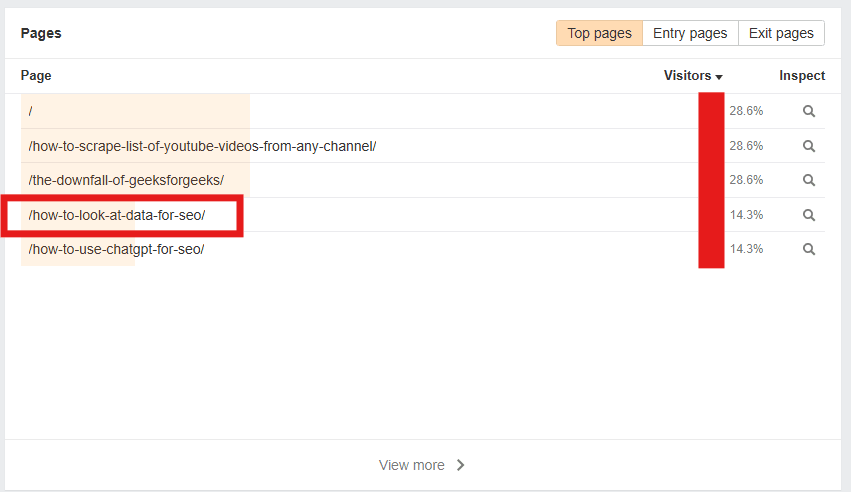
You can sign up for Ahrefs Web Analytics for free.
How to adjust your SEO strategy with data
Okay, framework aside, the real power comes from knowing where to look for data and what insights to pull. Often, the most valuable information isn't in the most obvious places. Here are some internal and external data sources, including some frequently overlooked ones, to build your strategy:
1# Internal data: look at your own data to understand things like what topics were successful in the past and brought more conversions for example or you have more authority in SERPs. For me I'm looking for topics that would be successful not only in search but also on LinkedIn as it's a main platform for me. You can also look at the time it took your blogs on average to start ranking and bringing traffic to estimate and forecast how long new blogs need to start driving results. So start with what you have!
Another great source of internal data that is more often than not overlooked is your PPC data. What's working and what's not, what's driving more conversions and what's not. These insights can help you decide what topics, keywords and business areas to focus on both to reduce your PPC spend or to improve your overall website CTR for those keywords.
2# External data: I'm not going to list all the traditional tools we use, I'm listing things we often miss out and do not use on a regular basis:
- Google trends and all the insights there!
- Keyword planner to find seasonality of keywords if any
- Wikipedia public analytics data (you can access this via Python) to understand interest in a topic
- Generic trends, you don't need to be working in PR to keep a tab on emerging trends in your industry. Remember when Chatgpt first launched, I wrote the blog "How to Use AI & Chatgpt for SEO" and it started to bring in traffic in no time! Trending topics are easy to capture and are often missed opportunities by SEOs because keyword research tools can show zero search volume for such new topics.
- Microsoft Clarity, which is a free tool that can help you analyze the user experience on your website. I highly recommend it.
In summary,
What I'm trying to say here is simple:
Actively seek out diverse data sources – both internal and external.
Your own internal data is often the best and most reliable starting point. Use lessons from your past performance to predict and create the future. This is data your competitors don’t have!
And when looking externally, remember there are many tools and data points beyond basic keyword research that can provide additional insights, helping you choose better tactics and make smarter strategic decisions.
Hope this inspires you a bit to look beyond keywords.
Thanks for reading so far and see you next newsletter!
The SEO Riddler Newsletter
Join the newsletter to receive the latest updates in your inbox.


